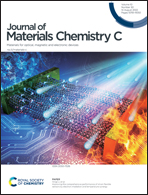Induced internal stresses and their relation to FLASH sintering of KNN ceramics†
Abstract
Electric field and current applied to an unsintered ceramic body are known to promote low temperature and extremely fast densification, in a process referred to as FLASH sintering. Under the current urgency of the green transition of manufacturing processes, FLASH sintering is a very promising technology for materials industry. Suitable FLASH conditions result in dense ceramics but many issues associated with the effect of electric field and current on local chemistry, structure, and microstructure remain to be understood. We have used FLASH sintering to produce K0.5Na0.5NbO3 (KNN), a lead-free compound suitable for piezoelectric applications. Using a combined X-ray diffraction and Raman spectroscopy study, here we show for the first time that, although the FLASH process may produce homogeneous ceramics with negligible concentration of secondary phase, macroscopic core-localized stresses remain which have significant consequences on the final properties of the sintered material. In addition, the internal stress state and its dependence on the local temperature during FLASH sintering are established by Finite Element Modelling (FEM). The identification of the fine structure of FLASH sintered materials is critical for understanding the unique properties developed under this sintering process and for its development as an alternative low thermal budget sintering technology.



 Please wait while we load your content...
Please wait while we load your content...